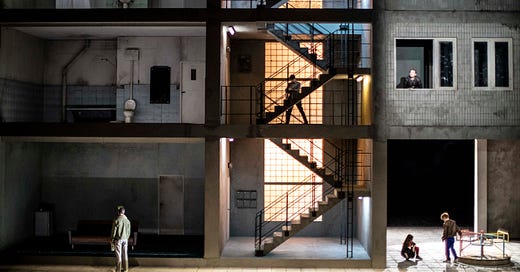Barbara Hanička’s concrete jungle apartment block set for Opéra de Lyon’s Katya Kabanová Picture by Jean-Louis Fernandez
It is only 18 years since the Opéra de Lyon presented a triptych of the Janáček productions originally created for Glyndebourne by the late Nikolaus Lehnhoff. Unforgettable as those performances undoubtedly were, the new Lyon general director, Richard Brunel, has now embarked on a new Janáček series, starting with Katya Kabanová (to be followed by his own staging of Vec Makropoulos).
Brunel entrusted Katya to an all-female artistic team: Polish director Barbara Wysocka with her compatriot set and costume designers Barbara Hanička and Julia Kornacka, and the Australian-Swiss conductor Elena Schwarz. Their concept of Janáček’s domestic tragedy is more modernist-brutalist than Lehnhoff’s: it reflects Wysocka’s feminist reading of the opera, in which the heroine is portrayed as a Mélisande-like free-spirit-cum-temptress, rather than a victim of the narrow-minded social mores of her tyrannical mother-in-law, Marfa Kabanová (Kabanicha).
Hanička’s decor, a concrete skeleton of the lower three floors of a tower-block, suggests a run-down urban estate, rather than the comfortably middle-class rural home evoked in Janáček’s libretto and score. With nondescript everyday clothes, there is little to suggest class distinction between the well-to-do Kabanov family and non-members of the household: in this context the ‘servants’ Glaša and Fekluša are, I suppose, either neighbours or bypassers rather than family employees.
Wysocka’s alienating approach is not unlike Calixto Bieito’s in his much-travelled staging of Jenufa, though lacking the exaggerated violence of the Catalan director’s conceptions. In any case, the violence in Katya Kabanová is primarily psychological rather than physical. On its own terms, the production makes the character conflicts clear enough, but Wysocka’s depiction of the Kabanov household - if her random collection of characters can be called that - fails to engage directly with the religious and moral hypocrisy of Kabanicha. The production underplays the mother-in-law-from-hell’s martinet domineering of her son and foster-daughter, Varvara and her determination to break Katya’s spirit.
Keep reading with a 7-day free trial
Subscribe to Operalogue to keep reading this post and get 7 days of free access to the full post archives.




